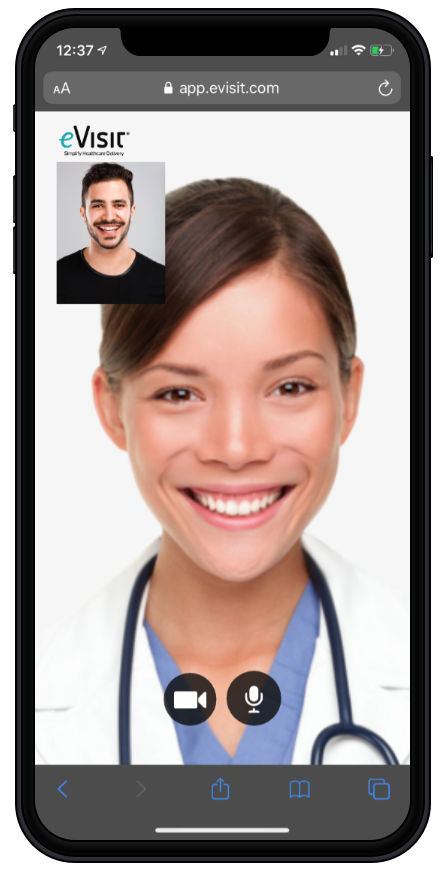Mesa-based eVisit has big plans. The company believes it has the key to solving what they see as the second-biggest problem in the world — healthcare.
Forget about the fact that politicians have been battling this out for decades. For eVisit, it’s not about policy, but accessibility.

After a rigorous review, Forrester Research recently named eVisit the solo Leader in virtual care platforms. eVisit was evaluated based on 28 criteria, and the company received the highest possible scores in 13 of them.
According to the Forrester report, “eVisit nails the platform side with its robust clinical interoperability, differentiated UI, and strong support for billing and reimbursement processes.”
This is great news, says eVisit CTO Miles Romney, because it signals the accomplishment of one of eVisits major goals — to become the U.S. market leader in healthcare.
“It’s validation that we are on the right track,” Romney says.
By 2050, eVisit envisions the ultimate approach to preventative healthcare, or “proactive healthcare,” according to Romney. He says the company’s road map leads to the ultimate goal that every person should have access to health care.

Romney describes eVisit’s solution as a system that gathers health information and delivers a personalized cocktail of what the person needs for healthcare management and treatment. In his ideal world, every household would have a modern shower stall outfitted with a high-tech system that includes a full-body CT scan and instruments that check health metrics and vitals. The data would then be sent to a care team and analyzed in real-time using artificial intelligence and validated by providers. Finally, a “transdermal infuser” delivers a mix of vitamins, relaxants, pain relievers, beta blockers and others, depending on the results of the tests.
“The shower begins and as hot water hits, one already feels the positive effects,” according to a summary on eVisit’s website.
But that’s a couple decades away. Right now, they’re working on fixing the telehealth system.
What’s wrong with telehealth?
Romney says there were (and still are) several problems with telehealth before eVisit came on the scene. The first problem was that telehealth companies weren’t working with healthcare providers and organizations. Each telehealth company has its own system with its own providers. When someone sees a provider from one of these companies, they’re meeting with a doctor they’ve never seen before and who doesn’t have many details of the patient’s medical history. In 2016, 20 million people saw a doctor they’d never met.
This trend is dangerous, Romney says, because it means that the online provider has no context for a patient’s symptoms. Also, the provider is also often out-of-state, so they’re likely unfamiliar with local health trends where the patient lives. Because of these and other factors, Romney says, the quality of the patient’s outcome will inevitably be lower.
The separate nature of these telehealth companies also means that they compete with hospitals and private practices. Hospitals, especially, can’t afford to lose patients. A lot of hospitals are only operating on 1-2% margins. If they lose too many patients, they become underfunded and can no longer perform essential treatments, like surgeries, that have to be performed locally.
How does eVisit address these problems?
The company was founded in 2014 by Bret Larsen. His initial goal was to simplify the way healthcare organizations deliver care to their existing patients. He wanted to build out next-generation tools that would enable healthcare workers to care for patients in the best and most efficient way possible. Ultimately, he believed one of the best ways to do this was with telehealth.
Before he started eVisit, Larsen was head of marketing at Stat Doctors, a Scottsdale-based company that provided affordable telehealth access for common medical conditions. While there, he had an opportunity to interview 5,000 consumers who had used the company and then dropped out. The most common response Larsen heard was that they wanted to be able to see their own doctor instead of someone they’d never met before.

This inspired Larsen to leave Stat Doctors and start eVisit. He hired Romney’s tech company to build the software, and Romney was so impressed by Larsen’s ambitious goal that he left his company to join eVisit as CTO.
The two started working to address the problems with telehealth using the technology Larsen envisioned. The platform provides a way for existing practitioners to begin incorporating telehealth into patient care, while keeping providers consistent for patients and allowing for a true health information exchange between telehealth visits, in-person visits and treatment plans.
Initially, eVisit was being used by small and mid-size practices, but has since moved to providing the telehealth platform to some of the Valley’s biggest enterprise healthcare providers, including Banner Health and Dignity Health. In fact, Romney says that Banner is very innovative in how they utilize the eVisit platform.
Phoenix has proven to be a great place for this platform to thrive, says Romney, there’s a lot happening here with healthcare. He says the company has been a “smashing success” in the Valley.
The company plans to continue to work with hospitals and other enterprise clients to empower them to consistently provide the best, most efficient and most accessible health care possible.
